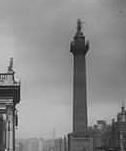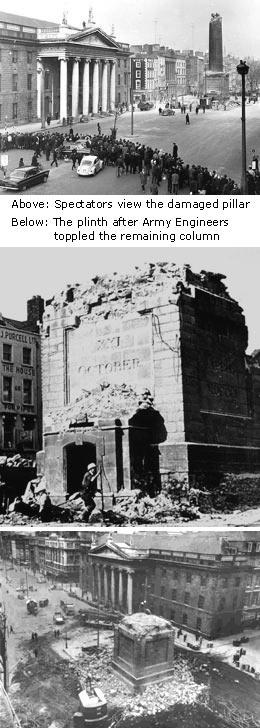Nelson's Pillar
|
|
Nelson's Pillar was a large granite pillar topped by a statue of Horatio, Lord Nelson, located in the centre of O'Connell Street in Dublin. It was erected in 1808 to honour Admiral Lord Nelson and the Battle of Trafalgar, three years after his death, and before the similar Nelson's Column was erected in London in 1849.
The pillar was a Doric column that rose 121 ft (36.8 m) from the ground and was topped by a 13 ft (3.9 m) tall statue in Portland stone by Cork sculptor Thomas Kirk, RHA (1781-1845), giving it a total height of 134 ft (40.8 m) – some 20 metres shorter than the more famous Nelson's Column in London. It was designed by Francis Johnson (1760-1829), the architect who built the General Post Office (to the left of the picture opposite). Johnson and later architects laid out Sackville Street (now O'Connell Street) so that the buildings, the GPO and the Pillar were in scale to the size and length of the street and to each other. The original entrance to the pillar was underground but G. P. Baxter designed a porch in 1894 which was added to allow direct access from the street.
The pillar became both a tram terminus and a common meeting place for Dubliners and offered the city's best public viewing platform, reached by spiral stairway inside the column.
Destruction of the Pillar
A group of former IRA men, including Joe Christle,1 planted a bomb that destroyed the upper half of the pillar at 2am on March 8, 1966, throwing the statue of Nelson into the street and causing large chunks of stone to be flung around the vicinity. Christle, dismissed ten years earlier from the IRA for unauthorised actions, was qualified as a barrister and saw himself as a socialist revolutionary. It is thought that the bombers acted when they did to commemorate the 50th anniversary of the Easter Rising. No one was hurt by the explosion. The closest bystander was 19-year-old taxi driver Steve Maughan, whose taxi was destroyed. O'Connell Street enjoyed a gay atmosphere for a few days as people crowded in to appreciate the novelty that was being referred to around town as The Stump.
Two days after the original damage, Irish Army Engineers blew up the rest of the pillar after judging the vestigial structure to be too unsafe to restore. These experts' explosion caused more destruction on O'Connell street than the original blast, breaking many windows and causing painfully-amused Dubliners to roll their eyes.
The rubble from the monument was taken to the East Wall dump and the lettering from the plinth moved to the gardens of Butler House, Kilkenny.
Ken Dolan and six other students2 from the National College of Art and Design stole the statue's head on St. Patrick's Day from a storage shed on Clanbrassil Street as a fund-raising prank to pay off a Student Union's debt. They leased the head for £200 a month to an antiques dealer in London for his shop window. It also appeared in a women's stocking commercial, shot on Killiney Beach, and on the stage of the Olympia Theatre with The Dubliners. The students finally gave the head to the Lady Nelson of the day about six months after taking it, and it is now in the Civic Museum in Dublin.
The Nelson Pillar Act was passed in 1967, transferring responsibility for the site of the monument from the Nelson Pillar Trustees to Dublin Corporation. The site was simply paved over by the authorities until The Spire of Dublin was erected there in 2003. A time capsule containing artefacts from 1808 was discovered 3 in the ground on October 2, 2001 when digging began to lay the foundations for the Spire.
On April 23, 2000, Liam Sutcliffe, 67, from the suburb of Walkinstown, claimed 4 on the RTE radio programme Voices of the 20th Century that he was responsible for blowing up the monument. Sutcliffe is a republican supporter who has been linked in the past to the Official Sinn Féin movement. He maintained that in Operation Humpty Dumpty the explosive used was a mixture of gelignite and ammonal. He declined to confirm his remarks when he received a visit at home from Garda Special Branch detectives four months after his radio interview, in August. Then, on the morning of September 21st, he was arrested under Section 30 of the Offences Against the State Act and invited to repeat his allegations at Store Street Garda Station. His reluctance to do so while in custody resulted in his release without charge that night. The Gardai prepared a file for review by the Director of Public Prosecutions to decide if the matter should be pursued further.
The identity of the bombers has been a source of speculation and conflicting claims of responsibilty, much like the empty boasts of many older Dubliners that they were in the GPO during the Easter Rising in 1916. One republican source even asserted 5 that the operation enjoyed the help of a Basque explosives expert owing to an alleged lack of expertise amongst the conspirators.
1 Armed Struggle: The History of the IRA by Richard English, Oxford University Press, 2003, ISBN 0195166051
2 The Irish Independent, March 11, 2003
3 The Irish Times, October 4, 2001
4 The Irish Independent, September 22, 2000
5 The Blanket: A Journal of Protest and Dissent, an online Republican journal. Dispatch 203 (http://dispatches.phoblacht.net/archive/dispatch203.htm) ? September 25, 2000
Songs about the fall of Nelson's Pillar:
[Fragment]
Up went Nelson in old Dublin
Up went Nelson in old Dublin
All around O'Connell Street
the bits of Nelson flew
When up went Nelson and the pillar too!
Lord Nelson by Tommy Makem
Lord Nelson stood in pompous state, upon his pillar high
And down along O'Connell Street he cast a wicked eye
He thought how this barbaric race had fought the British Crown
Yet they were content to let him stay right there in Dublin town!
So remember Brave Lord Nelson, boys,
He has never known defeat
And for his reward they stuck him up
In the middle of O'Connell Street!
For many years, Lord Nelson stood, and no one seemed to care
He would squint at Dan O'Connell who was standin right down there
He thought the Irish love me or they wouldn't let me stay,
All except that band of blighters that they call the IRA!
And then in nineteen sixty six, on March the seventh day,
A bloody great explosion made Lord Nelson rock and sway!
He crashed, and Dan O'Connell cried, in woeful misery
Now twice as many pigeons will come and shit on me!
Nelson's Farewell by Joe Dolan
Released as a track by The Dubliners
on their album Finnegan Wakes in 1966.
Well, that poor old Admiral Nelson
Is no longer in the air,
Sing toora loora loora looraloo,
On the eighth day of March in Dublin City fair,
Sing toora loora loora looraloo,
From his stand of stones and mortar,
He fell crashing through the quarter,
Where once he stood so stiff and proud and rude
So let's sing our celebration,
It's a service to the nation.
So poor Admiral Nelson Tooraloo.
Oh fifty pounds of gelignite
It sped him on his way,
And the lad that laid the charge,
We're in debt to him today
In Trafalgar Square it might be fair
To leave ould Nelson standing there
But no-one tells the Irish what they'll view.
Now the Dublin Corporation can stop deliberations,
For the boys of Ireland showed them what to do.
For a hundred and fifty seven years
It stood up there in state,
To mark ould Nelson's victory
O'er the French and Spanish fleet,
But one-thirty in the morning,
Without a bit of warning,
Poor Nelson took a powder and he blew.
Oh at last the Irish nation
Has Parnell in higher station
Than poor old Admiral Nelson tooraloo.
Well the Russians and the Yanks
With lunar probes they play
And I hear the French are trying hard
To make up lost headway
But now the Irish join the race
We've got an astronaut up in space
Ireland, boys is now a world power too
So let's sing our celebration,
It's a service to the nation,
So poor Admiral Nelson tooraloo.
See also: Irish statues and their nicknames


